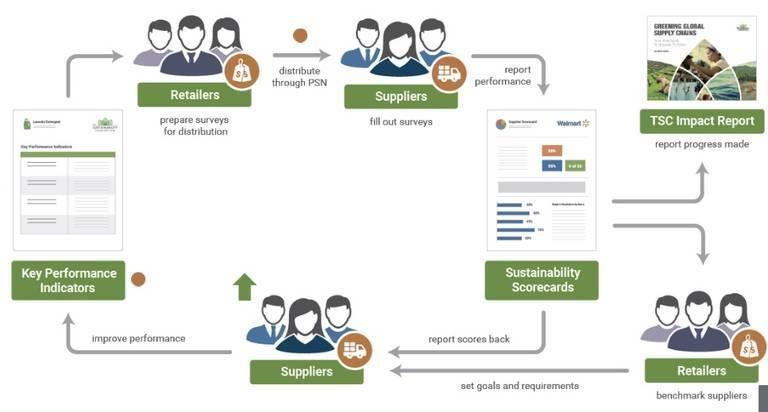
By Peter Seligmann
The economic case for sustainability in business is open-and-shut, with benefits including more engaged stakeholders and employees, deeper customer loyalty, improved innovation and financial performance, and more. Less apparent to businesses may be the process for sourcing materials and securing partners to form a more sustainable supply chain. For any business, securing an environmentally sound supply chain comes with challenges, from verifying the origins of each material to vetting partners that have adopted holistic “green” approaches. The globalization of both supply chains and communication has intensified the urgency to improve social responsibility around the goods and services we create and consume. The globe’s increasing interconnection also poses complex challenges, including opacity around supply chains in less-regulated nations and greater pressure toward transparency, applied with increasing force by billions of customers who have high-powered communication devices at their fingertips. But these challenges create greater opportunity for businesses to ply their efforts toward the greater good. Challenges in the Supply Chain One such challenge has been the abolition of slavery and human trafficking in the export-seafood industry in the South Pacific, which is projected to supply about 70 percent of the world’s seafood by 2030. The environmental community and the food industry had been concerned about how to manage those fish stocks in a smart, effective way in order to sustain them over the long term. As CEO of Conservation International, I traveled with Walmart chairman Rob Walton to the South Pacific to explore and better understand the sustainability issues inherent to the fishing industry there. We had one question in mind: Did the seafood production carry a heavy carbon footprint, or was it sustainable? Our perspectives broadened when authorities in the Cook Islands impounded a fishing vessel — common for trawlers suspected of fishing illegally — and jailed the sailors and crew. Once cleared for discharge, the crew members holed up in jail rather than return to the ship: They were slaves and refused to reenter captivity. We realized we’d need to expand the questions we were asking in order to understand — and track — these supply chains. The upshot was Walmart leading an effort, joined by many companies, to demand fish that’s not only sustainable, but also untouched by slave labor. In 2017, the retailer joined the Ocean Disclosure Project to add transparency to its seafood sourcing, expanded its sustainability policy to cover canned tuna, and further devoted itself to responsible sourcing that improves working conditions in the global supply chain. Actions for Businesses of All Sizes Sustainability efforts aren’t the exclusive purview of the S&P 500, though, as businesses of all sizes can improve their efficiency and competitiveness by shoring up their supply chains and featuring sustainable supply as a key offering. Adopt these strategies for ensuring your resources are sourced in environmentally and ethically sound ways: 1. Set standards for sources and suppliers. First, set high standards for your suppliers. For agricultural commodities such as soy, coffee, beef, or palm oil, look for certifications that the commodities were raised sustainably with the farmers having employed sound land-management practices. If certifications don’t exist, help your company set its own standard. Walmart, for example, thoroughly outlines its requirements to ensure that new or existing suppliers raise themselves to compliance. The retailer asks its suppliers 16 questions — topics include greenhouse gas emissions, water use, employment practices, and more — and scores them on its Sustainability Index. Walmart’s 150,000 suppliers all pass through this sustainability filter. The results have included higher-quality products, strengthened customer trust, and a more resilient supply chain. 2. Track the supply chain using technology. The push for greater transparency means more thoroughly mapped supply chains. The increasingly global movement of products makes verifying chain of custody murkier, yet more important, than ever. Digital platforms like Sourcemap use blockchain technology to help businesses dealing in food and fashion chart their supply chains and trace a product’s movements from one verified point to another. Tyson, Kroger, Walmart, and Unilever are among companies working with IBM to build a safer supply chain using the same technology. Blockchain can keep companies attuned to costs at each stage in a product’s life cycle and hold them environmentally accountable to both themselves and their buyers. 3. Forge partnerships with a common “why.” Partnerships help sustainability initiatives flourish, so identify collaborators that share your motivations and commitment. If your goal centers on a long-term problem such as forest conservation or seafood sustainability, work with parties whose enlightened self-interest aligns. An MIT Sloan Management Review study, conducted between 2009 and 2016, found that while 90 percent of executives think that sustainability success hinges on collaboration, only 47 percent saw their companies collaborating with stakeholders to induce strategic change. Before you embark on a partnership, set a new standard, or initiate other efforts, look for your unique why, probing beyond the common assumptions that sustainability matters to customers, investors, or regulators. Strategic opportunities for progress can’t exist without your first having discerned a strategic necessity. The benefits you reap from this exploration — reduced environmental cost and impact, fresh partnerships, and better supply continuity — may help sustain your business’s fortunes long-term. Peter Seligmann’s name has been synonymous with conservation and sustainability for more than four decades. In 1987, Seligmann founded the nonprofit Conservation International and spent 30 years as its CEO; he is currently its chairman. He is also the founding CEO of Nia Tero, an emerging global collaborative with a mission to advance indigenous peoples and local community stewardship of vital ecosystems around the world. Seligmann sees nature as the most precious currency, one that should be cherished and preserved by corporate executives, indigenous tribes, and everyone in between. Peter resides in Seattle. Illustration: Walmart Sustainability IndexTriplePundit has published articles from over 1000 contributors. If you'd like to be a guest author, please get in touch!














